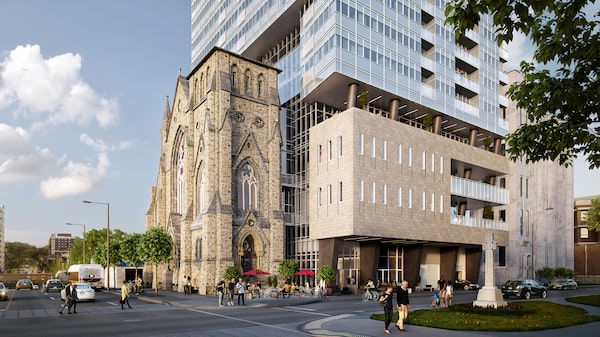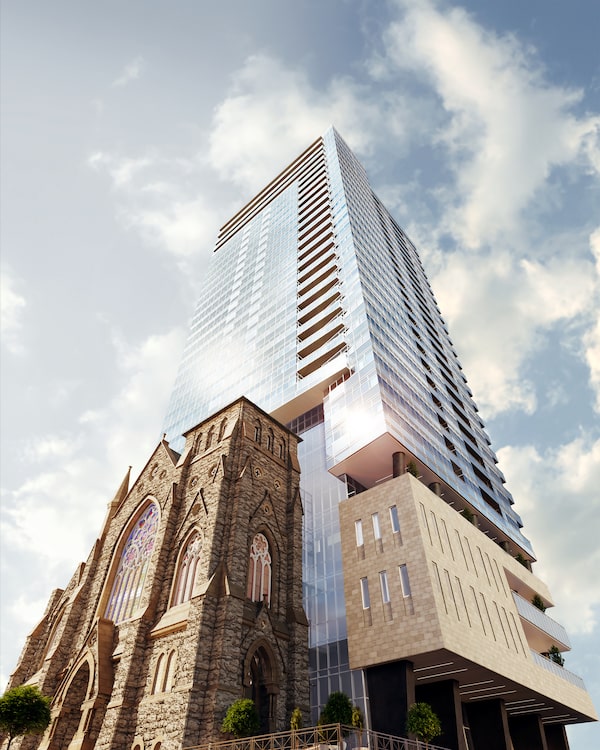
Hamilton’s James Street Baptist Church is being converted into a new high-rise condo project.Hue Developments and LCH Developments/Handout
Historically, communities have been built around churches. Now, the latest real estate trend is flipping this formula and turning these historical buildings into neighbourhood hubs.
Over the past few decades, church conversions have taken place in most major cities across North America. Whether it’s the shrinking congregation size or rising maintenance costs, the question is how to preserve these buildings for future generations, while keeping them relevant and useful for current use.
Over the years, a number of solutions have evolved. Some churches rent out space to help offset capital costs. Some building owners sell the property to developers or simply shutter the doors. Still others are repurposed and reimagined as new spaces to congregate either as concert halls, special-event venues or as condo-conversion residential units. It’s this last solution that appears to have a devoted following both among amateur renovators as well as professional developers. Consider the HGTV show House Hunters: Outside the Box, where buyers bid to buy unique properties such as decommissioned churches and out-of-use train stations that are now transformed into stunning residential homes.
This is precisely what is happening to Hamilton’s James Street Baptist Church. Designed by Joseph Connolly, and opened in 1882, the Ontario heritage building is the city’s oldest surviving Baptist church. Located in the Durand neighbourhood, between Gore Park and King William Street, the former church is just steps away from Hamilton GO Centre station and a stop along the planned LRT.
Yet, the structure sat in decline for years until a consortium that included the City of Hamilton as well as Vietnamese-based Hue Developments, architects mcCallumSather and Toronto-based project manager LCH gave the structure a second lease on life as the Connolly Condos.
Set to go on sale this fall, the project incorporates what remains of the church into the modern elegant design; the high-rise features a 30-storey mixed-use tower with 315 residential units, ground-floor commercial space and 7,000 square feet of amenity areas spread across two floors.
Developer hiccups almost scuppered this church conversion
For a while, it appeared there was no salvation for this building. Flashback to 2013, when developer Louie Santaguida bought the property via his company Stanton Renaissance. His plans were to build a condominium tower called the Connolly, but to do this, he needed to demolish two-thirds of the existing church building.
Heritage advocates protested, but in the end, Stanton was granted a permit to demolish all but the front third of the church. That happened five years ago. Since the demolition, the remaining church façade has stood behind a chain-link fence until the project finally went into receivership in 2017.
Another year went by and in walked Hue Developments, which bought the land in 2018.
“Certainly there were some in the core who didn’t feel confident the parcel was an attraction following the Stanton bankruptcy,” Ward 2 Hamilton Councillor Jason Farr says. “I will not forget one of the first meetings I had as a newly elected councillor in 2011. It was with the then-operators of the James Street Baptist. They had a declining congregation and growing capital and operating expenses. They wanted me to know they could no longer sink megabucks into a building that was literally crumbling each day. We met in the front corner office and before I sat down, they said, ‘Listen to the walls every time a bus goes by.’ I did.”

Extensive work was required to rebuild and fortify the church foundation, which is now the facade of the new Connolly high-rise project.Hue Developments and LCH Developments/Handout
Mr. Farr recalls how jarring the sound was when the bus rolled by. “You could hear the century-old mortar and stone falling between the walls.”
The project became a prime candidate for ‘façadism’ support, Mr. Farr says, which means it was eligible for zoning assistance and heritage grants and loans offered by the City of Hamilton.
“A third of this property is now protected by heritage designation and is set to be fully restored with assistance from some of the most robust municipal heritage grant and loan programs of any city in Canada,” he adds.
New developer has a strong desire to build and preserve
While Hue Developments is new to Canada, they are one of Southeast Asia’s top developers, with more than 20 years of real estate and construction experience. As the international arm of Hoa Binh, which trades on the Ho Chi Minh Stock Exchange, the firm currently has 92 projects under construction and operates in 40 provinces and four countries.
“Our biggest focus since taking over this project has been to do a better job at showcasing the church, and reintegrating it into the building and community,” says Luke Wywrot, managing partner at LCH, the Toronto-based real estate development firm hired to project manage this build. “We recognize Connolly’s impact will be greater than just the building; we are filling a void in Hamilton.”
McCallumSather, a mid-sized architecture firm headquartered in Hamilton is involved to help make sure the collective cultural heritage of this building is preserved. This bodes well for the project, given that mcCallumSather is known for award-winning innovative design and heritage projects, such as McMaster Institute for Music & the Mind and the Joyce Centre for Partnership & Innovation on the Mohawk College Campus – the first net-zero building in Ontario and the largest net-zero facility in Canada. Natural Resources Canada will award buildings the net-zero designation if the total amount of energy used by the building on an annual basis is equal to the amount of renewable energy created by the facility.
Deep emotional ties to heritage buildings
Drew Hauser, director at mcCallumSather, still recalls the day when two-thirds of the church was demolished four years ago. It was one of the toughest days of his career.
“That was the hardest emotional job I’ve worked on,” Hauser says. “People sent me personal messages and hate mail, basically saying, ‘How could you allow this building to come down? It is part of our cultural heritage.’ ” It was hard to hear for Mr. Hauser. Still, the veteran architect is confident. “We’ve supported a design that allows the most important parts of the building to remain and be relevant.”
By developing a design that retains an important piece of that collective memory, Mr. Hauser believes the city benefits in the long run.
“People have this collective memory of a place. Cities are not static. They are always in a state of flux. The building long outlasts us. The collective memory, those stories, continue on,” he says.
Connolly’s most iconic feature is a rose window that spans 30-feet across its façade. This is being incorporated into the condos’ state-of-the-art gym. In a way, exercise is like a religion for many, so it seems fitting that this iconic window will find its new home in a new place of worship.
This project is just one example of Hamilton’s broader transformation from its long-held label as Steeltown to a metropolis known for innovation, renaissance and constant growth.
For Mr. Farr, it’s about time.
“As a lifelong inner-city kid who endured decades of stagnation and even decline, it’s an honour to be in this seat with folks who are really into climbing on board and building on our city’s unprecedented momentum,” he says.